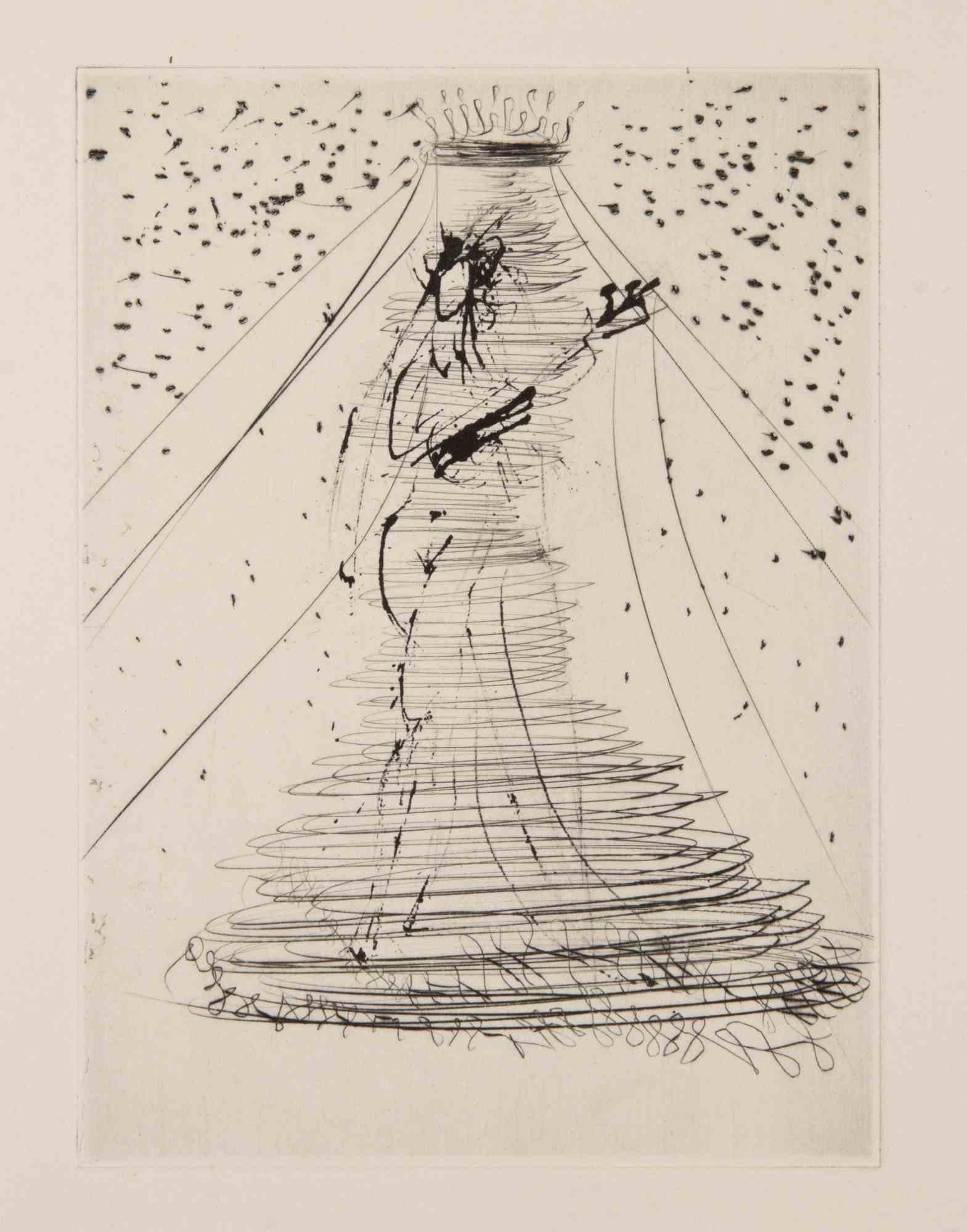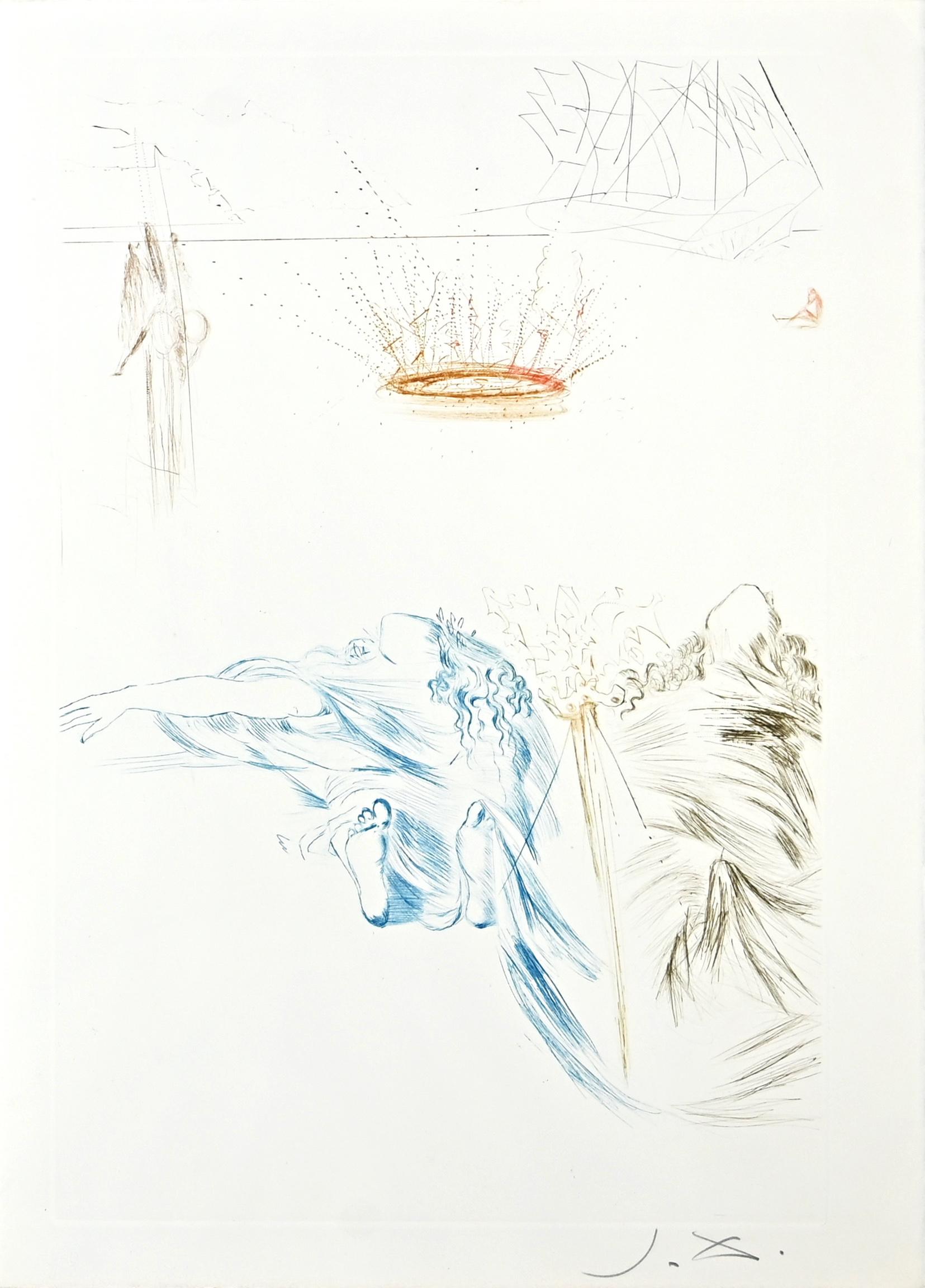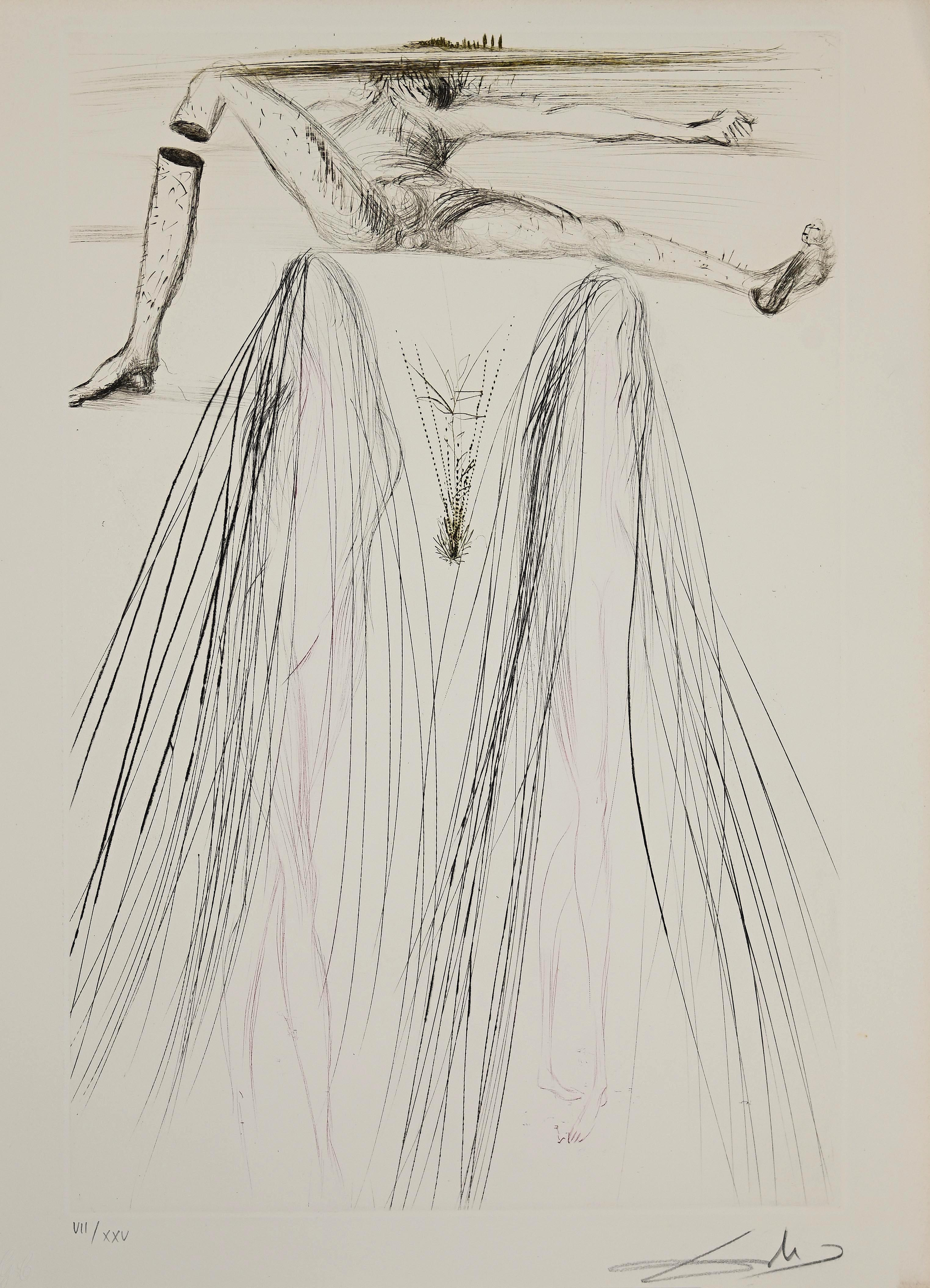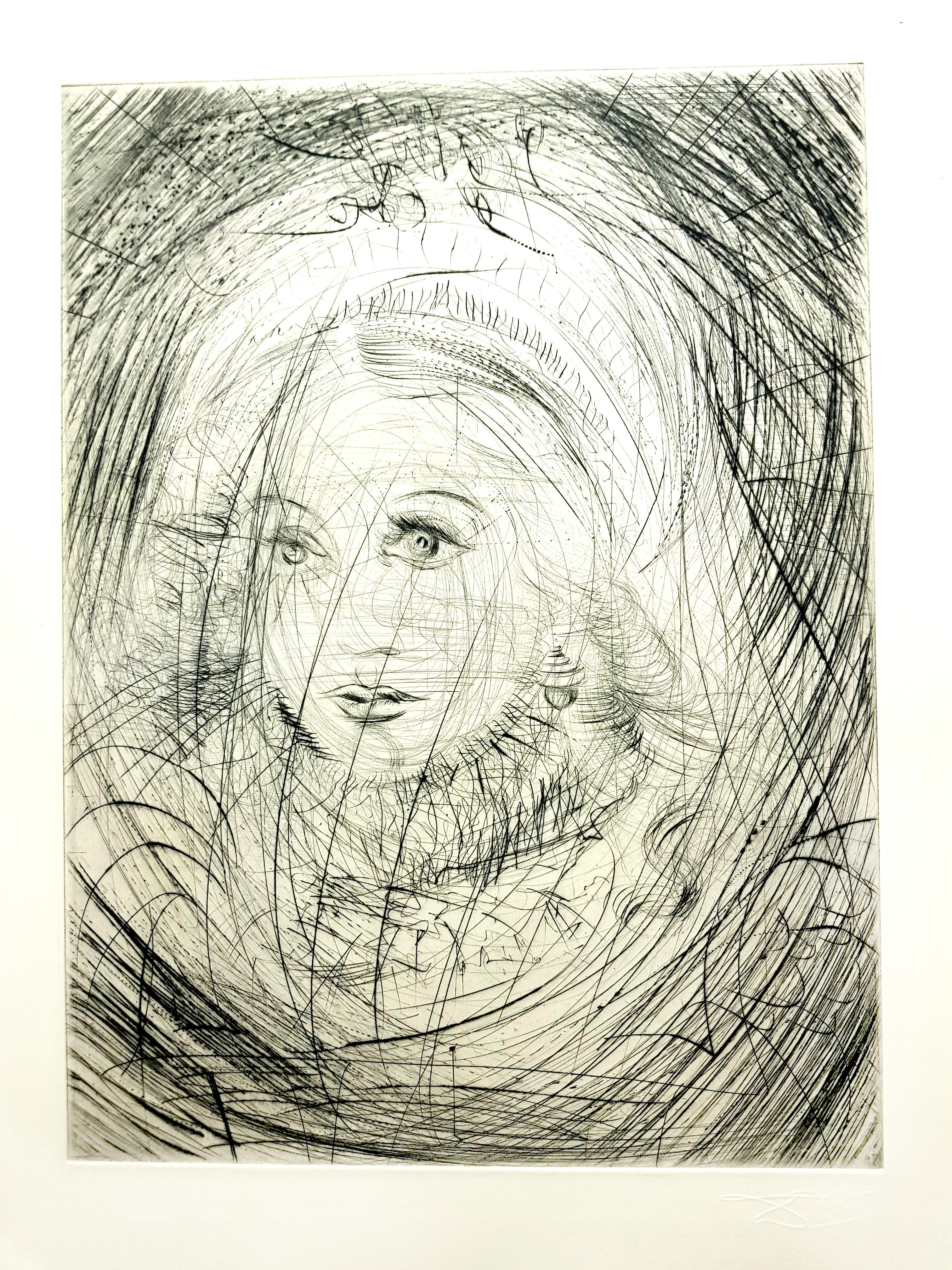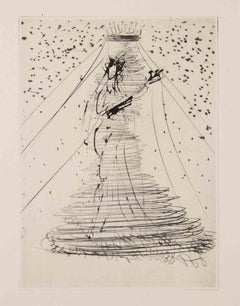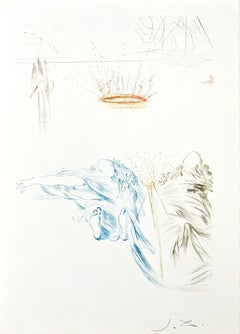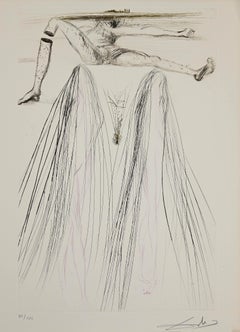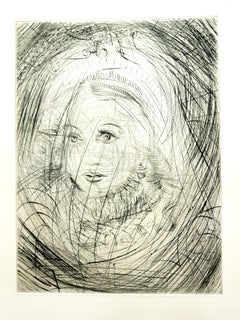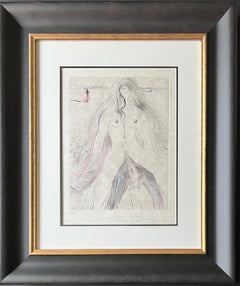Items Similar to La Reine avait Bliaut de Soie - Drypoint Etching attr. to S. Dalì - 1969
Want more images or videos?
Request additional images or videos from the seller
1 of 5
La Reine avait Bliaut de Soie - Drypoint Etching attr. to S. Dalì - 19691969
1969
$1,437.40
£1,074.85
€1,200
CA$1,980.38
A$2,159.89
CHF 1,144.16
MX$25,893.97
NOK 14,571.54
SEK 13,324.59
DKK 9,144.48
About the Item
Colour-printed drypoint etching, from the print collection of 21 etchings of “Tristan et Iseult”.
Monogrammed "S.D." ”in graphite on lower-right margin. Italian Edition, Wucua e Grafica Contemporanea: 125 on Lana, of which the first 25 copies contain a signed suite. Die stamp “G.C.” on the bottom left. In addition, 3 copies designated “A.C.”
This sheet of the print suite is in perfect condition and with fresh impression. One of the 21 illustrations realized by Salvador Dalí for the print suite of "Tristam and Iseult", published in 1969. Dalí here shows and illustrates in graphics one of his many interpretations of the myth of Tristram and Iseult, a very popular 12th-century tale of romance and tragedy of literature, music, and art. The story presents many different variations of the same plot.
Reference: R. Michler, L.W. Lopsinger, Salvador Dalì, Catalogue Raisonné of Etchings and Mixed-Media Prints, 1924-1980, Prestel, 1994, Munich, pag. 185, image n. 419
- Attributed to:Salvador Dalí (1904 - 1989, Spanish)
- Creation Year:1969
- Dimensions:Height: 17.33 in (44 cm)Width: 12.45 in (31.6 cm)Depth: 0.08 in (2 mm)
- Medium:
- Movement & Style:
- Period:
- Framing:Framing Options Available
- Condition:Insurance may be requested by customers as additional service, contact us for more information.
- Gallery Location:Roma, IT
- Reference Number:Seller: M-960001stDibs: LU650314946592
About the Seller
4.9
Platinum Seller
Premium sellers with a 4.7+ rating and 24-hour response times
1stDibs seller since 2017
7,851 sales on 1stDibs
Typical response time: 1 hour
- ShippingRetrieving quote...Shipping from: Roma, Italy
- Return Policy
More From This Seller
View AllThe Queen - Etching - 1968
By Salvador Dalí
Located in Roma, IT
Etching and drypoint realized to illustrate Pierre Ronsard's "Les Amours de Cassandre".
Published by Argillet, Paris, in 1968.
Edition of 299 pieces. One of 165 specimen on Arches...
Category
1960s Surrealist Figurative Prints
Materials
Etching
Le Testament de Tristan - Drypoint Etching attr. to S. Dalì - 1969
By Salvador Dalí
Located in Roma, IT
Le Testament de Tristan - From "Tristan et Iseult" is a modern artwork realized in 1969
Colour-printed drypoint etching, from the series of 21 etchings of “ Tristan et Iseult”.
Han...
Category
1960s Surrealist Figurative Prints
Materials
Paper, Etching, Drypoint
The Giant Beliagog - Drypoint attr. to S. Dalì - 1969
By Salvador Dalí
Located in Roma, IT
Hand signed. From the deluxe edition of 25 prints in Roman Numerals aside from the standard edition of 125. (There were 4 similarly-numbered editions in English, German, Italian, an...
Category
1960s Surrealist Figurative Prints
Materials
Drypoint
Le Spectre et la Rose - Etching after Salvador Dalì - 1960s
By Salvador Dalí
Located in Roma, IT
Etching on chamois-colored laid paper, realized by Dalì in 1968/69.
Plate from "Faust (La Nuit de Walpurgis), published by Argillet, Paris.
Edition of 49/150, hand colored.
Hand s...
Category
1960s Surrealist Figurative Prints
Materials
Etching
Femme au Clown - Etching - 1969
By Salvador Dalí
Located in Roma, IT
Etching and drypoint with roulette on Japanese paper from the Series "Faust" (Walpurgis Night).
Image dimension 32x24 cm.
Hand signed in pencil
Artist proof. Blindstamp "Dali", ou...
Category
1960s Surrealist Figurative Prints
Materials
Etching
Femme au Clown - Etching - 1960s
By Salvador Dalí
Located in Roma, IT
Etching on chamois-colored laid paper, realized by Dalì in 1968/69.
Plate from "Faust (La Nuit de Walpurgis), published by Argillet, Paris.
Edition of 49/150, hand colored.
Hand s...
Category
1960s Surrealist Figurative Prints
Materials
Etching
You May Also Like
La reine avait bliaut de sole ("The queen with silk tunic"), Etching, Handsigned
By Salvador Dalí
Located in Paris, IDF
Salvador DALI
La reine avait bliaut de sole ("The queen with silk tunic")
Original etching
Handsigned in pencil
Limited to 115 copies
On vellum Rives 45 x 32.5 cm
This etching is...
Category
1970s Surrealist Figurative Prints
Materials
Etching
Salvador Dali - Marguerite - Original Etching
By Salvador Dalí
Located in Collonge Bellerive, Geneve, CH
Salvador Dali - Marguerite - Original Etching from "Faust" suite
Stamped signature, as issued
From the standard edition of 731
Edition number 7
Dimensions: 38,5 x 28,5 cm
Edition Arg...
Category
1960s Surrealist Nude Prints
Materials
Etching
Knights of King Arthur - Original etching Handsigned (Field #70-10M)
By Salvador Dalí
Located in Paris, IDF
Salvador DALI
Les chevaliers du roi Arthur ("The cavaliers of King Arthut"), 1970
Original etching
Handsigned in pencil with his monogram
Limited to 125 copies
On Lana vellum 45 x ...
Category
1970s Surrealist Figurative Prints
Materials
Etching
Salvador Dalí – Femme à cheval - hand watercolored drypoint etching – 1969
By Salvador Dalí
Located in Varese, IT
hand watercolored drypoint etching on extremely fine Japanese paper, edited in 1969
limited edition of 145 copies water-colored
, numbered in lower left corner ea ( artist proof )
si...
Category
1960s Surrealist Prints and Multiples
Materials
Paper, Watercolor, Drypoint, Etching
Salvador Dali - Women - Original Etching
By Salvador Dalí
Located in Collonge Bellerive, Geneve, CH
Salvador Dali - Women - Original Etching
Embossed signature
From the edition of 731
Dimensions: 38,5 x 28,5 cm
1969
References : Field 69-1 / Michler & Lopsinger 305
Category
1960s Surrealist Nude Prints
Materials
Etching
Salvador Dali - Woman Holding a Veil - Original Stamp-Signed Etching
By Salvador Dalí
Located in Collonge Bellerive, Geneve, CH
Salvador Dali - Woman Holding a Veil - Original Stamp-Signed Etching
Stamp signed by Dali
Edition of 294 copies.
Edition number : 7
Paper : Arches vellum.
Dimensions : 16x12".
Cat...
Category
1960s Surrealist Figurative Prints
Materials
Etching
More Ways To Browse
Dior Stamp
A La Reine
Allison Lefcort On Sale
American Psycho
Ayako Rokkaku
Bassano Plates
Basya Wuensch Reiter
Calder Santa Claus
Camille Pissarro Signed
Carlos Merida Silkscreens
Carlos Schwabe
Chagall Coq
Chagall Moses Tablets
Chagall Offset Lithographs
Chagall Paradis
Charles Bragg Signed Prints
Dali Art Of Love
Dali Bird
